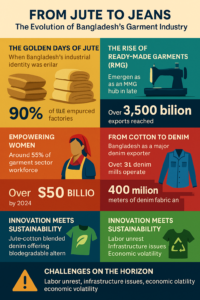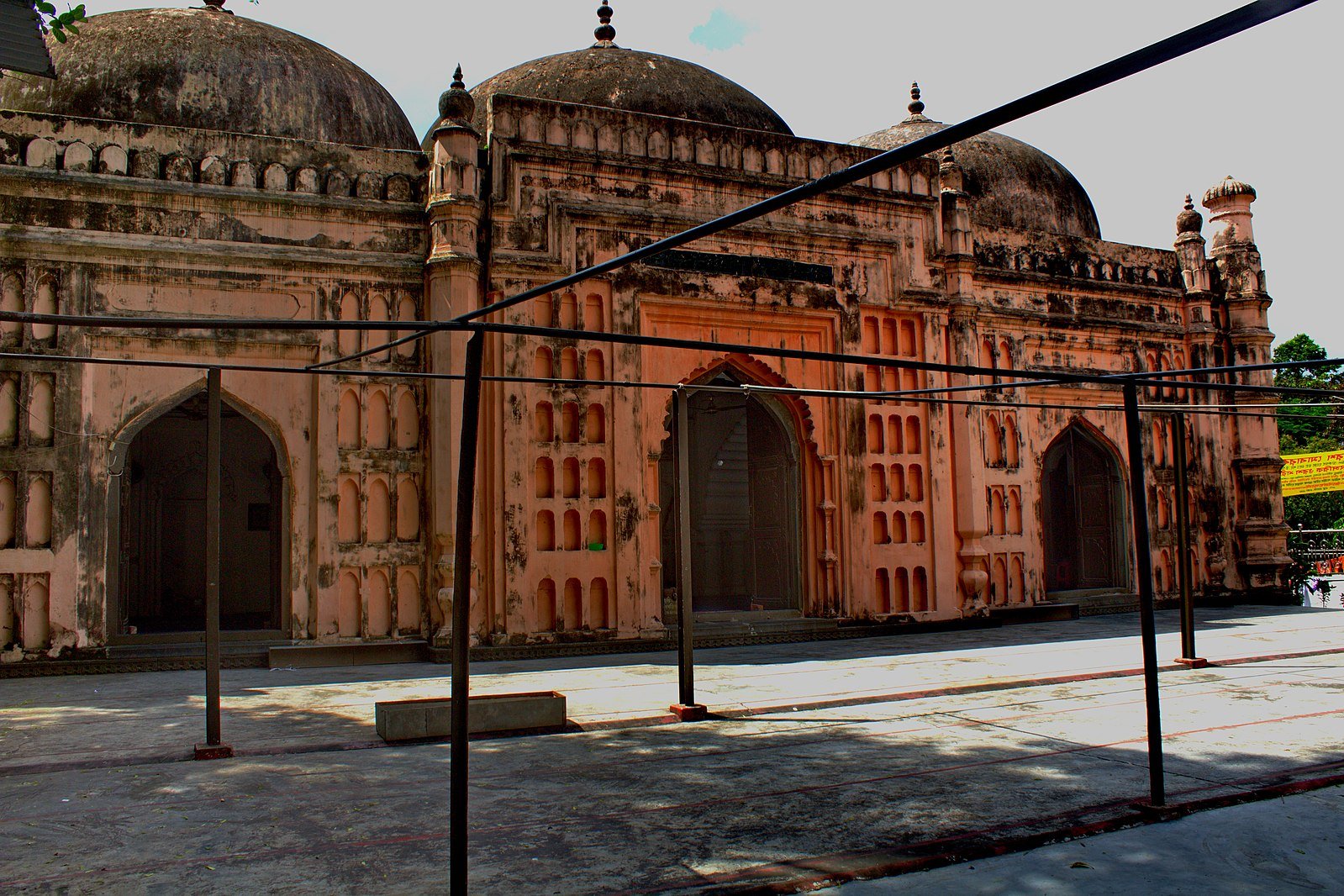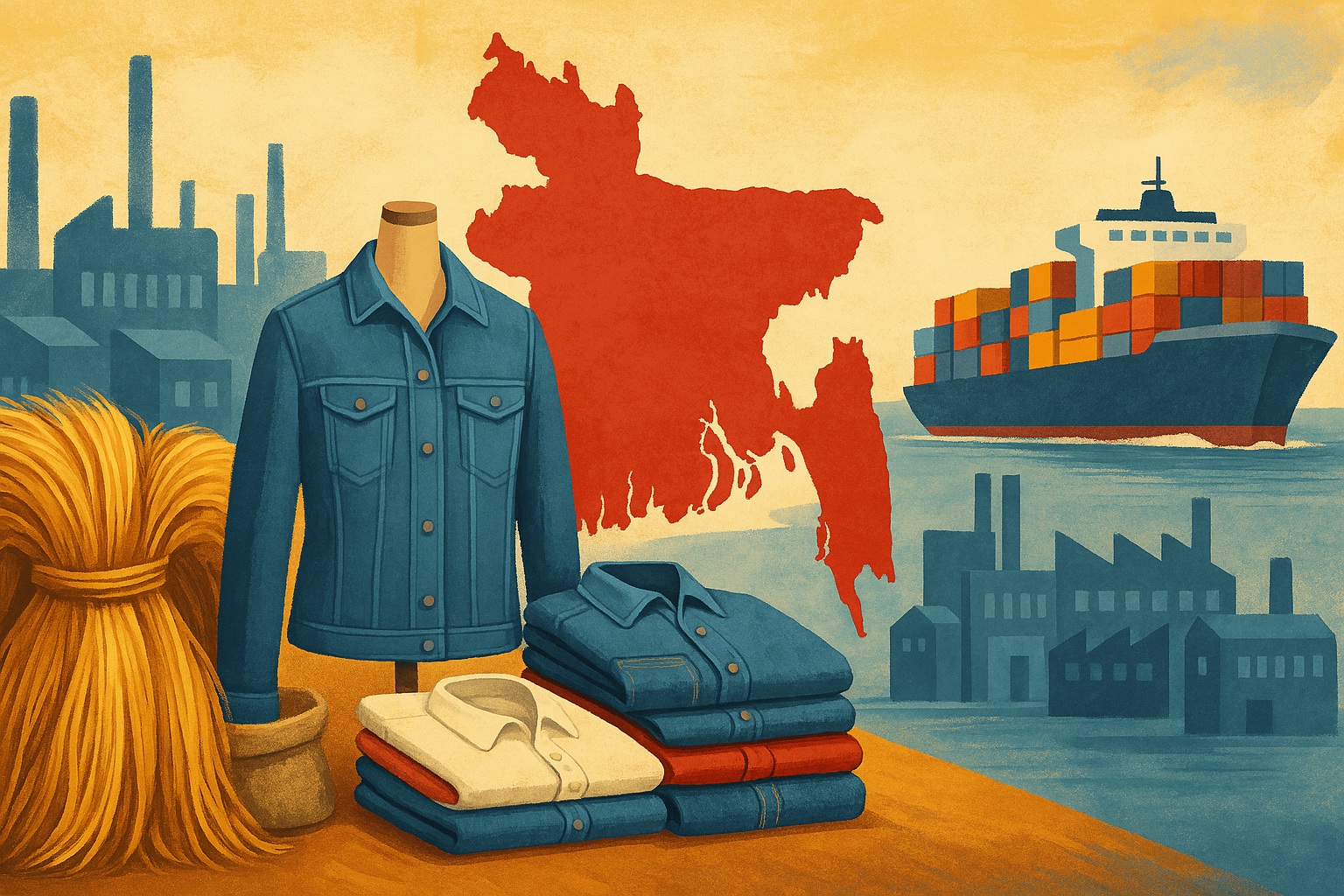Stitching Success: Bangladesh’s Journey from Jute Fields to Global Fashion Floors
Once known as the land of jute, Bangladesh has transformed into the world’s second-largest exporter of ready-made garments (RMG), trailing only behind China. This remarkable shift—from exporting natural jute fibers to mass-producing jeans and high-end fashion apparel—did not happen overnight. It is the result of decades of strategic policymaking, socio-economic shifts, industrial resilience, and global market dynamics.
In this article, we trace the journey of Bangladesh’s textile and garment industry, the rise of denim, the integration of sustainability, and the nation’s position on the global stage.
The Golden Days of Jute: Bangladesh’s First Industrial Identity
For decades following independence in 1971, jute—often called the “golden fiber”—was the mainstay of Bangladesh’s export economy. In the 1970s, jute and jute goods accounted for over 90% of the country’s total export earnings.
Bangladesh was home to some of the largest jute mills in South Asia, such as Adamjee Jute Mills, and supplied raw jute and jute products (sacks, ropes, carpets) worldwide. The natural fiber’s popularity was driven by its eco-friendly properties and affordability.
However, with the rise of synthetic substitutes like polypropylene and plastics in the 1980s, global demand for jute plummeted. Coupled with mismanagement and the failure to diversify jute-based products, the sector experienced a significant downturn.

The Rise of Ready-Made Garments (RMG): A Game-Changer
Bangladesh’s garment revolution began in the late 1970s, as the country sought alternatives to jute. Entrepreneurs started exploring the global apparel market, and the turning point came in 1978 when a local company—Desh Garments Ltd.—entered into a partnership with South Korea’s Daewoo Corporation. This joint venture trained Bangladeshi workers and introduced large-scale garment manufacturing to the country.
The 1980s and 1990s saw rapid growth, driven by:
- Export incentives and duty-free access to Western markets.
- Establishment of Export Processing Zones (EPZs).
- Low labor costs compared to global competitors.
- The phasing out of the Multi-Fiber Agreement (MFA) in 2005, which allowed least-developed countries like Bangladesh to capture more market share.
From only a few factories in the early 1980s, Bangladesh now has over 3,500 garment factories and produces clothing for global brands like H&M, Uniqlo, GAP, and Zara.
By 2024, Bangladesh’s RMG exports surpassed $50 billion, according to the Bangladesh Garment Manufacturers and Exporters Association (BGMEA), making it the second-largest garment exporter globally.

Empowering Women: A Social Revolution
One of the defining aspects of Bangladesh’s garment industry is its impact on female empowerment. Today, around 55% of the workforce in the garment sector are women—many of them from rural backgrounds. For these women, factory jobs have opened doors to financial independence, education, and greater participation in society.
This shift has also had a broader impact on gender norms and rural economies, as garment workers contribute directly to household income and decision-making.
From Cotton to Denim: Bangladesh’s Fashion Forward Move
In recent years, denim has become a key product category. Bangladesh is now the third-largest denim exporter to the U.S. and one of the top two denim suppliers to the EU.
Key stats:
- Over 31 denim mills operate in Bangladesh.
- They produce over 400 million meters of denim fabric annually.
- Brands like Levi’s, Wrangler, and Diesel source a significant portion of their jeans from Bangladesh.
What sets Bangladeshi denim apart is the combination of cost-competitiveness, large-scale production capacity, and increasing investments in sustainable technologies.

Innovation Meets Sustainability: The Return of Jute?
Interestingly, jute is making a comeback—this time in a new form. Researchers and textile manufacturers are experimenting with jute-cotton blended denim, offering a biodegradable alternative to traditional denim. This innovation taps into the growing global demand for sustainable fashion.
Bangladesh also leads in green garment factories. As of 2024:
- Bangladesh has over 200 LEED-certified green factories, the highest in the world.
- The world’s top 10 green garment factories are all located in Bangladesh.
This green transition is not just about optics—it reduces water consumption, lowers carbon emissions, and aligns with the ethical sourcing policies of global brands.
Strong Global Partnerships
Bangladesh’s success in the garment sector is underpinned by strategic partnerships with international buyers and governments:
- H&M, Inditex (Zara), Primark, and others rely heavily on Bangladeshi factories for fast fashion.
- The European Union and Canada offer duty-free access under schemes like Everything But Arms (EBA).
- Recently, Bangladesh has diversified into high-value apparel segments like sportswear, lingerie, and outerwear to move up the value chain.
Moreover, with increasing investments in automation, digital tracking, and compliance auditing, Bangladesh is ensuring it remains a reliable and ethical sourcing destination.
Challenges on the Horizon
Despite its stellar growth, the RMG industry is not without challenges:
- Labor unrest and wage disputes occasionally disrupt production.
- Poor infrastructure, especially roads and ports, add to lead times.
- Global economic volatility (such as post-COVID slowdowns) has impacted order volumes.
- Over-reliance on basic garments like t-shirts and trousers puts Bangladesh at risk of price competition.
However, the government and industry leaders are actively working to address these issues through:
- Infrastructure mega-projects (like Padma Bridge and Dhaka-Chattogram expressway),
- Digitalization of supply chains, and
- Emphasis on skills development and compliance.
From Jute to Jeans: What the Future Holds
Bangladesh’s journey from being a jute exporter to a denim superpower is an inspiring tale of transformation. As the country moves toward graduation from LDC status in 2026, it is also preparing for new global trade dynamics.
To stay competitive, Bangladesh must:
- Diversify its product range,
- Continue investing in green technologies,
- Enhance worker welfare and safety, and
- Move toward branding its own products rather than just being a manufacturer.
Initiatives like Made in Bangladesh Week, organized by BGMEA, are already promoting the country’s strengths on the global stage.
The Journey Ahead
Bangladesh’s garment industry is more than just an economic success—it’s a social movement, an engine of empowerment, and a symbol of resilience. From the rustling jute sacks of the 1970s to the sleek denim jeans worn across New York and Milan, Bangladesh’s textile narrative is constantly evolving.
By embracing innovation, sustainability, and inclusive growth, Bangladesh has proven that even the smallest countries can stitch together a global legacy—one seam at a time.
Up next: Explore how Bangladeshi women are driving economic change through digital transformation in the post-COVID era








